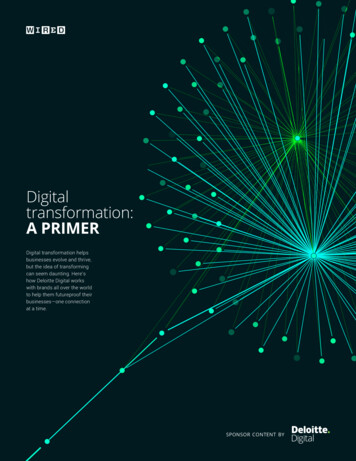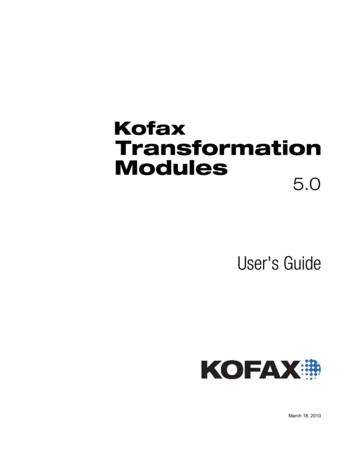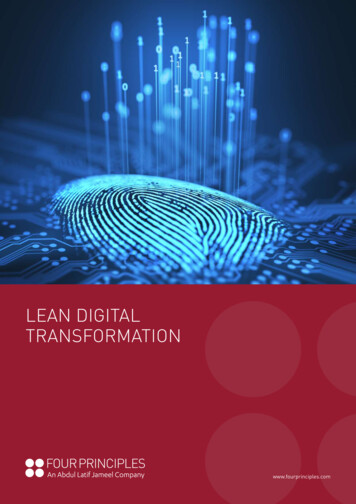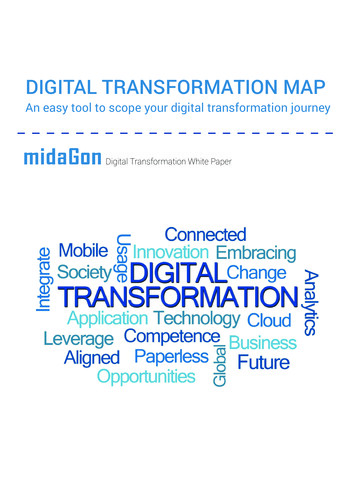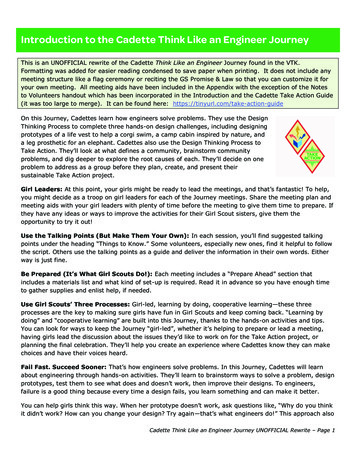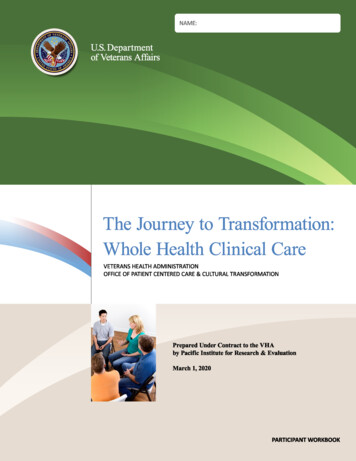
Transcription
AGENDAThe Journey to Transformation:Whole Health Clinical CareDAY 1 MORNING: READING THE “MAP”TimeTopic/Title7:30am – 8:00amRegistration8:30am – 9:00am2. Being the Change, Part 1: Your Mission Purpose in Your Work The Purpose of the Work8:00am – 8:30am9:00am – 9:05am9:05am – 10:15am10:15am – 10:30am10:30am – 11:30am11:30am – 12:30pm1. Welcomes and Course Overview OPCC&CT and Site Welcomes Why We Are Here: Objectives Course Materials and Community AgreementsMovement3. Team Introductions: Who is in the Room? Faculty Introductions Site by Site Introductions Divide up by Roles: Speed Dating ActivityBreak4. The Journey to Transformation: Fundamentals The Essence of WHCC The WH Designation Framework Success StoriesLunch
The Journey to Transformation:Whole Health Clinical CareDAY 1 AFTERNOON: SETTING THE COMPASS HEADINGTimeTopic/Title12:30pm – 1:15pm5. “Aim”-ing High: The Ultimate WHCC Destination Shooting for the Stars Small and Large Group Debriefs1:15pm – 1:20 pm1:20pm –2:15pm2:15pm – 2:45pm2:45pm – 3:30pm3:30pm – 4:15pm4:15pm – 4:30pmMovement6. Aim Statements: Getting to the First Milestone Aim Statements: The Basics Group Activity: Your Aim StatementBreak7. Adjusting Your Aim: Where Do You Really Want to Go? Faculty Introductions Site by Site Introductions Divide up by Roles: Speed Dating Activity8. Now You Know Where You’re Going.How Will You GetThere? A Memo from Your Chief of Staff The People Side of Change Six Essential Questions RevisitedWrap Up, Pulse Checks, and Adjourn
The Journey to Transformation:Whole Health Clinical CareDAY 2 MORNING: PLANNING THE JOURNEYTimeTopic/Title7:30am – 8:00amRegistration8:15am – 8:45am9. Being the Change, Part 2: Ikigai9:20am – 9:25amMovement10:15am – 10:30amBreak8:00am – 8:15amPulse Check Review, Mindful Awareness, Plan for the Day8:45am – 9:20am10. SWOT’s Happening? A New Lens Small Groups Report Out on SWOT Findings People and SWOT: The People Side of Change9:25am – 10:15am10:30am – 11:30am11:30am – 12:30pm11. Our Transportation to Success Workgroup Time: The People Side of Change The Three-Legged Stool12. Using the New Lens: ADKAR Skills Your Barrier Point Change Participants and Impacted GroupsLunch (can be a working lunch, as desired)
The Journey to Transformation:Whole Health Clinical CareDAY 2 AFTERNOON: PLANNING THE JOURNEY (CONT’D)TimeTopic/Title12:30pm – 12:45pm13. Bridges, Trees, and Bears – Oh My!: Navigating Barriers Introduction to the 7 Key Elements12:45pm – 1:45pm1:45pm – 2:00pm2:00pm – 3:00pm14. Element 1: Communication Overview, Considerations, and Tips Group Time: MessagingBreak15. Element 2: Sponsorship Overview, Considerations and Tips Group Time: Sponsor Checklists3:00pm – 3:05pmMovement4:25pm - 4:30pmWrap Up, Pulse Checks, and Adjourn3:05pm – 4:25pm16. Element 3: Resistance Management Overview, Considerations, and Tips Group Time: Tactics for Managing Resistance Groups Pair Up: Perspective Taking
The Journey to Transformation:Whole Health Clinical CareDAY 3 MORNING: PLANNING THE JOURNEY (CONT’D)TimeTopic/Title7:30am – 8:00amRegistration8:15am – 8:55am17. Element 4: Coaching Overview, Considerations, and Tips Group Time: Supporting Managers Supporting Change8:00am – 8:15am8:55am – 9:00am9:00am – 10:00am10:00am – 10:15am10:15am – 11:15am11:15am – 11:30am11:30am – 12:30pmPulse Check Review, Mindful Awareness, Plan for the DayMovement18. Element 5: Nuts and Bolts Overview, Considerations, and Tips Logistics: Tracking and Coding, EMR, PDSAs, Teamwork Group Time: Nuts and Bolts ChecklistBreak19. Element 6: Training Overview, Considerations, and Tips Whole Health Education Resources Group Time: Training20. Element 7: Circling Back Getting Feedback, Filling Gaps, and Celebrating Successes Group Discussion: Reinforcing ChangeLunch (can be a working lunch, as desired)
The Journey to Transformation:Whole Health Clinical CareDAY 3 AFTERNOON: HITTING THE TRAILTimeTopic/Title12:30pm – 1:00pm21. Final Workgroup Time2:00pm – 2:15pmBreak3:10pm – 3:15pmMovement4:00pm – 4:25pm25. Closing Activity1:00pm – 2:00pm22. Group Reports with Feedback, Part 12:15pm – 3:10pm23. Group Reports with Feedback, Part 23:15pm – 4:00pm24. The Journey to Transformation: Next Steps Sequel Activities The Next 10 Days.and Beyond4:25pm -4:30pmWrap Up, Evaluations, and AdjournThank You for Joining Us!
THE JOURNEY TO TRANSFORMATION: WHOLE HEALTH CLINICAL CARETABLE OF CONTENTSWelcomes and Course Overview . 3Circle of Health . 3Whole Health System Diagram. 4Module 4. The Journey to Transformation: Fundamentals. 5Whole Health Educational Core Compentencies for Clinicians . 5Applying Whole Health . 6Whole Health Clinical Care Process. 7Whole Health Clinical Care Flow . 7Excerpts from Designation Framework for Whole Health Implementation . 8Whole Health Clinical Care Resources . 23Module 5. “Aim”-ing High: The Ultimate WHCC Destination . 25Ultimate Destination Activity Guide . 25Module 6. Aim Statements: Getting to the First Milestone . 28Aim Statement Template . 28SMART Goal Summary – How to Write a WHCC SMART Goal . 29Module 8. Now You Know Where You’re Going How Will You Get There? . 30Six Essential Questions. 30High Reliabilitiy Organization, Six Essential Questions. 32Five Tenets of Change Management . 34Module 10. SWOT’s Happening? A New Lens . 35SWOT Self-Assessment . 35Module 11. Our Transportation to Success. 37Prosci Project Change Triangle & Triange Expanded. 37Foundations for Change Assessment . 38Module 12. Using the New Lens: ADKAR Skills . 42Prosci ADKAR Model—Summary. 42How Does Change Really Happen? It’s ADKAR! . 43Engaging Change Participants and Impacted Groups . 46Module 13. Bridges, Trees, and Bears – Oh My!: Navagating Barriers . 48List of the Seven Key Elements . 48Module 14. Element 1: Communication . 49Communication—Key Messaging Guidelines . 49VA Office of Patient Centered Care & Cultural TransformationMarch 20201
THE JOURNEY TO TRANSFORMATION: WHOLE HEALTH CLINICAL CAREKey Messaging Guidelines for Executives . 51Key Messaging Guidelines for Managers . 53Key Messaging Guidelines for Employees. 55Module 15. Element 2: Sponsorship . 57Primary Sponsor Checklist for Planning and Start Up . 57Primary Sponsor Checklist for Implementation. 59Preparing Sponsors Tool . 60Module 16. Element 3: Resistance Management . 64Resistance Assessment Worksheet . 6410 Tactics for Managing Resistance . 65Module 17. Element 4: Coaching. 67Prosci Coaching Plan Template . 67Module 19. Element 6: Training . 69Whole Health Education Offerings Summary . 69Module 22. Group Reports with Feedback, Part 1. 72Guidelines for Presenting Your WHCC Action Plan . 72Reflections on How to Apply Whole Health . 73Blank Pages for Notes . 81Day 1—Pulse Check. 85Day 2—Pulse Check. 87Day 3—Pulse Check. 892VA Office of Patient Centered Care & Cultural TransformationMarch 2020
THE JOURNEY TO TRANSFORMATION: WHOLE HEALTH CLINICAL CAREWELCOMES AND COURSE OVERVIEWCIRCLE OF HEALTHThe Circle of HealthTo learn more visit: https://www.va.gov/WHOLEHEALTH/VA Office of Patient Centered Care & Cultural TransformationMarch 20203
THE JOURNEY TO TRANSFORMATION: WHOLE HEALTH CLINICAL CAREWHOLE HEALTH SYSTEM DIAGRAMKey Elements of the Whole Health System4VA Office of Patient Centered Care & Cultural TransformationMarch 2020
THE JOURNEY TO TRANSFORMATION: WHOLE HEALTH CLINICAL CAREMODULE 4. THE JOURNEY TO TRANSFORMATION:FUNDAMENTALSWHOLE HEALTH EDUCATIONAL CORE COMPENTENCIES FOR CLINICIANS-updated January 2020 1In order to support effective education on Whole Health, while still allowing creativelicense and the ability to tailor to the needs of your facility, please reference thesefive Core Competencies and associated Learning Objectives as you create anddeliver presentations.The goal is to cover all five Core Competencies with your audience over time.CompetencyHelp Veterans explore their ownhealth and well- being, and (ifVeteran is ready) co-create aPersonal Health Plan with theVeteran, their families and healthcare teams, incorporating patientvaluesLearning Objectives Ask patients what matters most to them and help them explore themany areas of their lives that may impact health and well-being Support understanding of the critical role of self-care in healthand well-beingo Utilize the Personal Health Inventory and Circle of Health astools to help engage patients in their own self-careo Appreciate the role of mindful awareness in supporting healthand well-being Co-create shared goals for health and well-being with patients (ifthey are ready) Explain to patients and other colleagues what Whole Health is and itsroll-out in VHA, including what a Whole Health System is2Work effectively as a member ofan interprofessional team Optimize outcomes by effectively utilizing differentinterprofessional team members, including traditional teammembers, as well as patients, families, peers, health coaches, CIHprofessionals, etc. Utilize effective teamwork strategies, including appreciative inquiryand developing skills in team communication and facilitationtechniques3Demonstrate advanced skills incommunication, empathy andfacilitation of behavior change inVeterans and families Optimize the potential healing impact of a therapeuticrelationship, including effectively conveying empathy and caring Demonstrate skillful conversations that facilitate behavior change4Integrate CIH therapies and useCIH professionals as appropriateand informed by evidence andpatient values and preferences Incorporate patient values/preferences along with evidence inco-creating a care plan with patients that may include CIH Use mind-body discussions and techniques to help support healthand well-being Have awareness of one’s own values/preferences for care plans andconsider the potential impact on clinical outcomes5Apply a Whole Health approach tosupport my own (staff) health andwell-being Consider what matters most to me (staff) in my own life Use a mind-body-spirit approach to explore and support myown health and well-being Describe the impact of staff well-being on patient interactionsand outcomesVA Office of Patient Centered Care & Cultural TransformationMarch 20205
THE JOURNEY TO TRANSFORMATION: WHOLE HEALTH CLINICAL CAREAPPLYING WHOLE HEALTH6VA Office of Patient Centered Care & Cultural TransformationMarch 2020
THE JOURNEY TO TRANSFORMATION: WHOLE HEALTH CLINICAL CAREWHOLE HEALTH CLINICAL CARE PROCESSWHOLE HEALTH CLINICAL CARE FLOWVA Office of Patient Centered Care & Cultural TransformationMarch 20207
THE JOURNEY TO TRANSFORMATION: WHOLE HEALTH CLINICAL CAREEXCERPTS FROM DESIGNATION FRAMEWORK FOR WHOLE HEALTH IMPLEMENTATIONThe following sections are excerpted from the Designation Framework for Whole Health Implementation. The full document is available at:https://dvagov.sharepoint.com/ layouts/15/AccessDenied.aspx?p 2&type accessremoved&correlation 1693349f-4028-a000-e2b5a0c019e771d6. These materials will help you assess what phase you are in when it comes to implementing your action plan.EXECUTIVE SUMMARY AND BACKGROUNDEXECUTIVE SUMMARYBegin with the end in mind. --Stephen CoveyThe VA is committed to large-scale implementation of the Whole Health System (WHS). Delivering Whole Health is a key component of VHA Modernizationefforts and is embedded within the Department of Veterans Affairs 2018-2024 Strategic Plan: “the VA will significantly improve Veteran health outcomes byshifting from a system primarily focused on disease management to one that is based on partnering with Veterans throughout their lives and focused on WholeHealth. VA will provide personalized, proactive, patient driven health care to empower, equip, and encourage Veterans to take charge of their health, well-being,and to adopt healthy living practices that deter or defer preventable health conditions.” The Designation Framework for Whole Health Implementation wasdesigned with a Veteran-driven system of care mindset to describe the future state when the Whole Health System is implemented and what will change fromthe site perspective and, even more importantly, from the Veteran perspective.PREPARATIONGOVERNANCEWHAT DOES THE FUTURE STATE LOOK LIKE?OPERATIONSWHAT WILL BE DIFFERENT FOR THE VETERAN? DomainsPATHWAYWELL-BEINGPROGRAMWHOLE HEALTHCLINICAL CAREEMPLOYEEWHOLE HEALTHCOMMUNITYPARTNERSHIPSFOUNDATIONAL DEVELOPMENTALFULL Phase 1Key milestone accomplishments are described foreach phase within each domain.It is anticipated that sites will work through WHimplementation at different paces.How these accomplishments are achieved may varyfrom site to site.Phase 3Phase 2Maturity8Phase 4The Designation Framework for Whole Health Implementation addresses“Where are we going?” It describes desired outcomes along the four phases ofthe Whole Health implementation journey. To achieve these outcomes, keymilestone accomplishments have been identified and organized around sevendomains: Governance, Operations, Pathway, Well-Being Program, Whole HealthClinical Care, Employee Whole Health, and Community Partnerships. It is NOTthe intent of the model to prescribe how a site achieves each accomplishment;rather, the goal is to provide sites with the latitude and flexibility tooperationalize processes and practices towards each accomplishment,encouraging exploration of local considerations and creative paths.To assist sites in determining “Are we there yet?” a WHS Self-Assessment tool isavailable. It is recommended you read this document in its entirety beforecompleting the WHS Self-Assessment Tool. This tool is intended to be used inconjunction with other OPCC&CT resources and with FIT consultation.VA Office of Patient Centered Care & Cultural TransformationMarch 2020
THE JOURNEY TO TRANSFORMATION: WHOLE HEALTH CLINICAL CAREDESIGNATION FRAMEWORK FOR WHOLE HEALTH IMPLEMENTATION: BACKGROUND AND CONTEXTBACKGROUND: Like the “Department of Veterans Affairs 2018-2024 Strategic Plan” and VHA Modernization efforts, the Designation Framework for WholeHealth Implementation was designed with a Veteran-driven system of care mindset. Implementing Whole Health represents a comprehensive and systematicapproach to provide whole health care at any stage of the relationship between VA and the Veteran. Moving from episodic to a holistic approach, it emphasizesself-care in the larger context of well-being, incorporating a full range of conventional and Complementary and Integrative Health (CIH) approaches to optimizelifelong Veteran health and well-being. The VA Whole Health System is based on three central components: Pathway; Well-Being Program; and Whole HealthClinical Care. The Personal Health Plan—a living document which grounds the approach to care in what matters most to the Veteran—forms the basis ofdecision-making and treatment planning as the Veteran moves through and across the continuum of care. Clinical practice is changing from a primary focus on‘What’s the matter with you?’ to one that asks, ‘What matters to you and how can we help you live your best life?’ Rather than solely chasing disease, the goalis to optimize health and well-being as viewed through the Veteran’s lens.The Designation Framework was designed to describe the future state when the Whole Health System is implemented and what will change from the siteperspective and, even more importantly, from the Veteran perspective. It is a forward-looking framework that describes desired outcomes along the WholeHealth implementation journey. To achieve these outcomes, key milestones were identified through the cumulative efforts and review by a multi-disciplinaryworkgroup (represented by OPCC&CT, EPCC/CHOIR, VISN and the field) as well as several content reviews by Whole Health subject matter experts and 10volunteer VHA sites/facilities. In doing so, a common set of objectives and accomplishments were established. It is anticipated the Designation Framework willcontinue to evolve as we all learn from each other and teach each other in collaboration.PURPOSE: To make transformational change, like large-scale implementation of the Whole Health System, the future state should be clear in terms of what willchange from the site perspective and, even more importantly, from the Veteran perspective. The Designation Framework addresses the question “Where arewe going?” The journey towards Whole Health transformation is more than changing actions or completing activities. It is about changing habits and behaviorsto ultimately impact our system values and beliefs. The Designation Framework describes this transformational journey, which ultimately (in theory) wouldresult in full transformation and designation as a Whole Health system via a certification process.HOW TO USE THIS MODEL: The Designation Framework was NOT designed to provide the details and granularity for Whole Health implementation. Rather, theDesignation Framework focuses on desired outcomes in terms of what will be different at the site and most importantly for the Veteran. Specifically, theDesignation Framework outlines milestones and accomplishments sites can achieve as they progress through four phases of Whole Health transformation andcultural maturity: Preparation, Foundational, Developmental, and Full. It describes key accomplishments across each phase and organized around sevendomains of focus: Governance, Operations, Pathway, Well-Being Program, Whole Health Clinical Care, Employee Whole Health, and Community Partnerships.How these accomplishments are achieved may vary from site to site. It is anticipated and understood that sites will work through Whole Health implementationat different paces, and how each site will integrate Whole Health with other existing programs, services, partners, and stakeholders (e.g., Mental Health, HealthyLiving Teams, PACT, Social Work, Public Affairs, Nursing, VSOs, etc.) will differ based on local site considerations.VA Office of Patient Centered Care & Cultural TransformationMarch 20209
THE JOURNEY TO TRANSFORMATION: WHOLE HEALTH CLINICAL CARERemember, it is NOT the intent of the Designation Framework to prescribe HOW site achieves each accomplishment. Instead, the goal is to provide sites withlatitude and flexibility in how they choose to operationalize processes and practices towards each accomplishment, encouraging exploration of localconsiderations and creative paths. As sites progress through each phase, each site will promote partnerships within existing VA/VHA programs and exploreexpansion capabilities and offerings via multiples options in service of milestone achievement.Guidance and recommendations on the “how” can be obtained via multiple resources offered by the Office of Patient Centered Care and CulturalTransformation (OPCC&CT), to include OPCC&CT FIT consultation and Whole Health System Implementation Guide. Ultimately, achievement of thesemilestones along all four phases provides a site the opportunity to apply for distinguished recognition as a premier Whole Health facility. A site must completeall accomplishments along the four phases before pursuing certification and designation as a fully transformed Whole Health System facility.WHOLE HEALTH SYSTEM (WHS) SELF-ASSESSMENT TOOL: To assist sites in determining “Are we there yet?” a WHS Self-Assessment tool to accompany theDesignation Framework is available. Accomplishments from each phase of the Designation Framework have been transferred into this tool as discrete elementsthat can be scored individually. Intended for individual site use, the WHS Self-Assessment tool can aid a site in identifying and organizing Whole Health initiativesand priorities, and potentially apply it to the development of a VISN and/or site strategic plan and/or project plans, thus bridging the gap between the currentstate and future state vision.ADDITIONAL CONTEXT: In June 2018, a Whole Health Designation Model Workgroup comprised of OPCC&CT, QUERI, Field and VISN representatives was stoodup to design the framework. The Workgroup took the following approach regarding maturity along the phases and organization of the accomplishments. Theterm “Whole Health Designation Model” was ultimately changed to “Designation Framework for Whole Health Implementation”.The focus of each phase is: 10Phase 1 Preparation: Preliminary stages of implementation, such as planning (which should include intentional milestones ranging from initialimplementation of core Whole Health offerings to expansion of efforts beyond initial start-up), conducting assessments, completing gap analyses, anddetermining how best to reach Veterans along the Designation Framework phases. This process will include decisions about whether to start mostly oncampus/in-house versus beyond the campus/within the community and when to explore expansion. Design efforts should be conducted from the lens ofthe Veteran with intent to evaluate and validate accessibility and effectiveness in engaging, empowering, and equipping Veterans.Phase 2 Foundational: Implementation of the core structure and processes with the primary support hub at the main campus. The intent is to introduceboth Veterans and employees to Whole Health and begin embedding personal health planning as the integral foundation for exploring what mattersmost.Phase 3 Developmental: Sustainment of the core structure with proactive efforts to expand and enhance the existing foundation through active andcontinuous evaluation and validation of efforts to reach and partner with Veterans, connect them to Whole Health approaches, and to explore andinitiate expansion of capabilities (i.e. telehealth, CBOCs, community). The intent is to enhance integration of the Whole Health System components.VA Office of Patient Centered Care & Cultural TransformationMarch 2020
THE JOURNEY TO TRANSFORMATION: WHOLE HEALTH CLINICAL CAREPhase 4 Full: Focus on cultural evolution of the site as a Whole Health System which results in Veteran-driven care and lifelong optimization of healthand well-being for Veterans. Because the site is focused on the integration of care with the Personal Health Plan (PHP) as the basis for criticalconnections and coordination, the site is a welcomed and trusted partner. The site offers a variety of points of entry into the system, expands offeringson an ongoing basis to meet Veteran demand, and is working towards full integration with all domains of the Designation Framework.The Workgroup catalogued certain topics within the Governance and Operations domains rather than repeating them in multiple domains. For example, thefollowing topics were assigned to the Governance domain: Strategic planningMetrics trackingPerformance measurement and outcome evaluationsLeadership engagement, leadership development and leadership experiential trainingWhereas the following topics were assigned to the Operations domain: Veteran engagement and inputCommunications (internal and external) to include Veteran outreach and Whole Health marketing and brandingHiring staffing, performance appraisals, credentialingStaff training with the experiential element being a critical distinguishing factorDocumentation and coding infrastructureFacility and space planningSome topics were purposefully repeated to emphasize its importance. Language about Veteran’s Mission, Aspiration, and Purpose (MAP), Personal HealthInventory (PHI) tool, Personal Health Planning (PHP) documentation, and personal health planning are emphasized in multiple domains given the foundationthese play in a Veteran-driven system of care. The interface and integration of the Whole Health System (WHS) component domains are repeated throughout topromote accessibility to each of the WHS components in supporting Veterans, families, and caregivers.Referral processes are also found in multiple domains: in the Operations domain to emphasize the infrastructure piece, as well as the WHS component domainsto emphasize the behaviors and actions related to use of referrals in the integration of the Whole Health approach.Special thanks to the Workgroup members:Anika Doucette (OPCCCT FIT), Eileen Dryden (EPCC/QUERI), Donna Faraone (OPCC&CT FIT), Linda Harrison (OPCC&CT), Justeen Hyde (EPCC/QUERI), Maureen Khung (OPCCCT FITLeadership), Pamela LeDeaux (VISN Network Sponsor), James Marzolf (OPCC&CT), Christine Palarca (OPCC&CT), Lauri Phillips (OPCC&CT Leadership), Mary Quilty (MITRE), CraigTriscari (OPCC&CT FIT), Kelly Unrein (WH Administrative Director), Stacy Valenti (OPCC&CT).VA Office of Patient Centered Care & Cultural TransformationMarch 202011
THE JOURNEY TO TRANSFORMATION: WHOLE HEALTH CLINICAL CAREGOVERNANCEDomain Transformative ObjectiveAs a fully transformed organization:Leadership commitment to Whole Health concepts are evidenced by their seamless incorporation into the organization’s broader strategic planand operational decision-making. In addition, leadership demonstrates commitment to Whole Health in attitude, behaviors and day-to-dayconversation and interactions with staff at all levels in the organization.Veteran participation and engagement in organizational decision making is embraced by leaders and staff at all levels, and such partnershipsare considered critical to organizational strength and are based on mutual trust and respect.Domain Components: Veteran engagement and input with feedback mechanismsGovernance structure and processes are integrated, reflect adoption of Whole Health behaviors and mindsetWhole Health is incorporated and woven into strategic planningLeader
Use mind-body discussions and techniques to help support health and well-being Have awareness of one’s own values/preferences for care plans and consider the potential impact on clinical outcomes 5 Apply a Whole Health approach to support my own (staff) health and well-being




